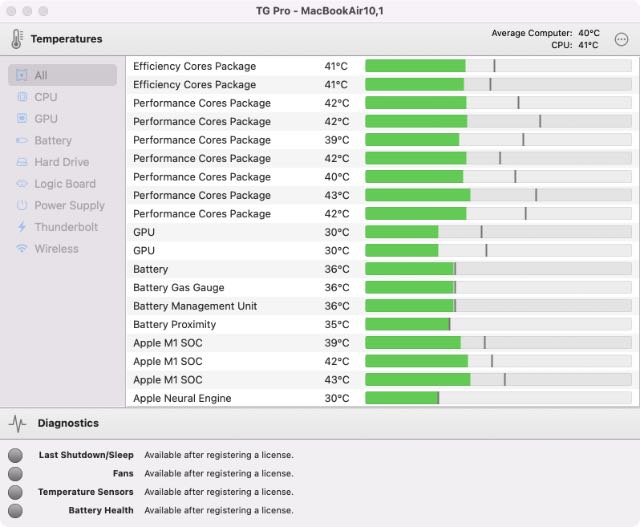
- #Macs fan control ideal temp how to
- #Macs fan control ideal temp manual
- #Macs fan control ideal temp mac
It's a last resort, particularly for such a stylish machine, but sometimes you have to bite the bullet and buy a laptop cooler for your MacBook Air. You might want to give these codes to Apple if you need to make a Genius Bar appointment to repair your Mac. The basic test should be enough to detect fan problems.Īfter the diagnostics are complete, make a note of any error codes or other information you get. Older Macs using the Apple Hardware Test give you the option of a Basic or a Thorough test. On newer Macs, Apple Diagnostics should start testing automatically. Select a language (if prompted), then follow the on-screen instructions. Press the Power button to restart your Mac, then press and hold the D key.
#Macs fan control ideal temp mac
Shut down your Mac and connect the power cable. More recent models, use Apple Diagnostics.ĭon't worry, both diagnostics tests are quite similar, and you access them in the same way: If your MacBook Air was made before June 2013, it'll use the Apple Hardware Test. You can test the fans on your MacBook Air using built-in diagnostic software.
#Macs fan control ideal temp how to
For everyone else, find out how to test your fans below.

If you've got an Apple Silicon MacBook Air (with an M1 chip inside it) you don't have any fans, so you can skip this step. Sometimes, you can obviously hear a problem with your fan if it stutters and grinds audibly. If your problems are more pronounced and your MacBook Air is regularly shutting down, you may need to test your fans. Still, if your fans are whirring loudly and it's heating up to a worrying temperature, here's how to cool down your MacBook Air. Apple simply didn't design these slimline laptops for processor-intensive tasks, which is why the MacBook Air gets hot so easily. The board generates heat as it works, and that heat only has one route of escape. Intensive processing tasks like rendering video effects, playing games, or opening too many browser tabs take their toll on your Mac's logic board and processor. Worse than that, the M1 MacBook Air doesn't even have a fan, making it potentially more prone to overheating if you manage to push the Apple Silicon chip hard enough. It's likely that this problem is down to the compact design with only a single vent-at the hinge of the screen-to aid heat dispersal. The MacBook Air from 2020 appears to be particularly prone to overheating problems. These are issues that every computer contends with, but MacBook Air models seem to experience more overheating issues than most. The CPU temperature will also stay in this healthy temperature range.ĭownload Macs Fan Control on the dev's website, on github, or from my local mirror (v4.1.12).All sorts of problems might make your MacBook Air hot, ranging from a buildup of dust to a load of browser tabs. So since we need to make sure the PSU does not overheat and melt your display panels LED strips on the right side, we set the CPU fan speed in relation to the PSU temperature. I learned that Apple did decide to "cool" the PSU by blowing the CPUs hot air onto it. Set the CPU fan to be controlled by the PSU Primary temperature. This stuff is sitting in the middle of the iMac case. If your disk runs hotter, you'll shorten its lifetime and jeopardize your data. 40☌ – 75☌ (this controls the right hand side of the iMac) The HDD fan is controlled by the HDD temperature.

#Macs fan control ideal temp manual
Here's my settings: Set everything to manual ODD Fan is controlled by GPU Diode.

So I decided to set up the fans manually, the Mac now runs much cooler and still it's not too loud. Macs Fan Control indicated that the PSU was running on 70☌ and more, and something made a buzzing sound (like a wire dangling inside a fan, which was not the case). Yesterday I encountered a customers iMac which ran crazy hot on the backside.


 0 kommentar(er)
0 kommentar(er)
